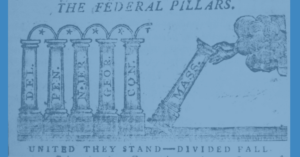Beyond the Amistad: The antislavery legislative career of John Quincy Adams
On February 21st, 1848 Representative John Quincy Adams rose on the House floor to vote no on a resolution designed to celebrate the United States’ victory in the recent war with Mexico. Adams would never make it out of the capitol that day, as he suffered a stroke and died shortly thereafter, making this vehement protest vote not only his last official act but his last earthly deed.
Adams is a man remembered chiefly for three things: being the son of the country’s second president, being the intellectual powerhouse behind the early Federalist party, and serving as the most inconsequential sixth president of the young republic. Yet the most interesting chapter of his public life came later, after his humiliating defeat in the presidential election of 1828 at the hands of Andrew Jackson. Feeling that his public work was not yet finished, Adams ran for and won a House seat representing his native Massachusetts district just two years after leaving the White House. He would go on to win nine consecutive terms before he literally died while doing the job.
Adams spent much of his House career as an increasingly outspoken political opponent of slavery. He was not a pure abolitionist, but he did become one of the earliest vocal critics of slavery to hold a high profile in elected office. Most famously, Adams argued before the Supreme Court in the 1841 Amistad case. The Spanish ship Amistad was transporting several dozen kidnapped Africans from Cuba to the United States. After a revolt on board, the ship docked in New York harbor and a legal fight ensued. It pitted the Africans arguing for their rights as free persons to be returned to Africa against the Spanish government, which owned the ship, arguing that the kidnapped persons were slaves and could be sold. Eventually, the case reached the Supreme Court, with the Van Buren administration arguing against the captives’ freedom. A group of New York abolitionists hired Adams to represent their side in arguments before the high court. Adams delivered a theatrical performance that succeeded in persuading the court that U.S. law required that the captives aboard the ship should be returned to Africa, rather than sold into slavery.
The culmination of these efforts was his strident opposition to the Mexican War, instigated by President James Polk yet supported by many Americans. Adams viewed the annexation of Texas, which happened in 1845 and had become a hotly contested public policy debate the year before, as little more than a guise to extend slavery into the west and to deepen its political power in Washington. Adams (along with Abraham Lincoln, then a new legislator) was one of just a few to vote against the declaration of war with Mexico, which had begun as a deeply controversial issue but had ended with an overwhelming vote of support in both houses of Congress.
Today we live in an age where the presidency is considered the crowning achievement in the life of anyone who achieves it. Today’s former presidents go on to write glamorized autobiographies, get paid huge sums for speaking engagements, and almost always are remembered fondly by many Americans once they have been out of office for a few years. They go on to run foundations and find causes to dedicate time to, but they almost always recede from the day to day policy debates that arise after they leave office. John Quincy Adams gives us a different model for life after the presidency: continued engagement in public deliberation over the nation’s future course. Long after leaving the presidency, Adams continued to educate the nation’s citizens and remind its leaders of the fundamental principles that should guide policy on the greatest problem it faced.



